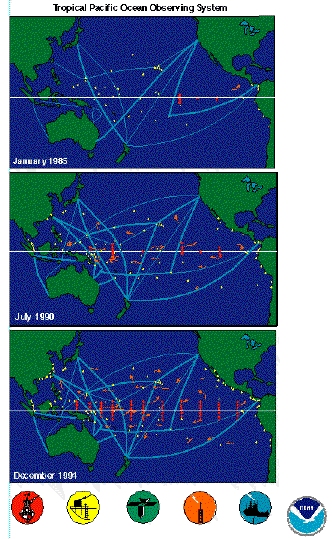 NOAA / PMEL
/ TAO Project Office / El
Nino Theme Page
NOAA / PMEL
/ TAO Project Office / El
Nino Theme Page
Tropical Ocean Observing System
The in-situ Tropical Ocean Observing System (below) was developed under the
auspices of the Tropical Ocean Global Atmosphere (TOGA) program. It is now
evolving into an
operational El Nino/Southern Oscillation (ENSO) observing system.

Top panel shows the observing system in January 1985 at the start of TOGA; middle panel shows the observing system in July 1990 at the approximate mid-point of TOGA; bottom panel shows the observng system in December 1994 at the end of TOGA. The four major elements of this observing system are:
- a volunteer observing ship expendible bathythermograph program (shown by schematic ship tracks)
- an island and coastal tide gauge network (circles)
- a drifting buoy program (shown schematically by curved arrows)
- a moored buoy program consisting of wind and thermitor chain moorings (shown by diamonds) and current meter moorings (shown by squares).
Thick ship tracks indicate expendible bathythermograph sampling at > 90 percent of levels considered to be optimal; thin ship tracks indicate sampling at 50-90 percent of optimal levels. One drifting buoy schematic represents 10 actual drifters. Only those tide gauge stations are shown that reported their data to the TOGA Sea Level Center in Honolulu within two years of collection. However, by December 1994, most measurements made as part of this four element observing system were being reported in real-time, with data relay via either geostationary or polar orbiting satellites.
Growth of the array is summarized as follows:
Jan 85 Jul 90 Dec 94
Drifters 8 164 263
Tide gauges 43 88 116
VOS/XBT Lines 10 18 18
Moorings 7 21 69
The Tropical Ocean Observing System (above) is now evolving into an
operational El Nino/Southern Oscillation (ENSO) observing system.
Nancy Soreide, Nancy.N.Soreide@noaa.gov
Disclaimer | Privacy Policy
 NOAA / PMEL
/ TAO Project Office / El
Nino Theme Page
NOAA / PMEL
/ TAO Project Office / El
Nino Theme Page